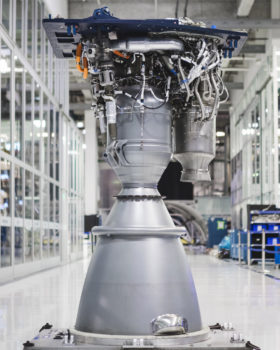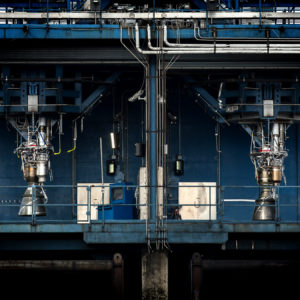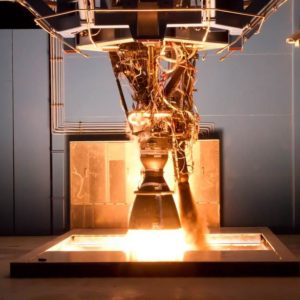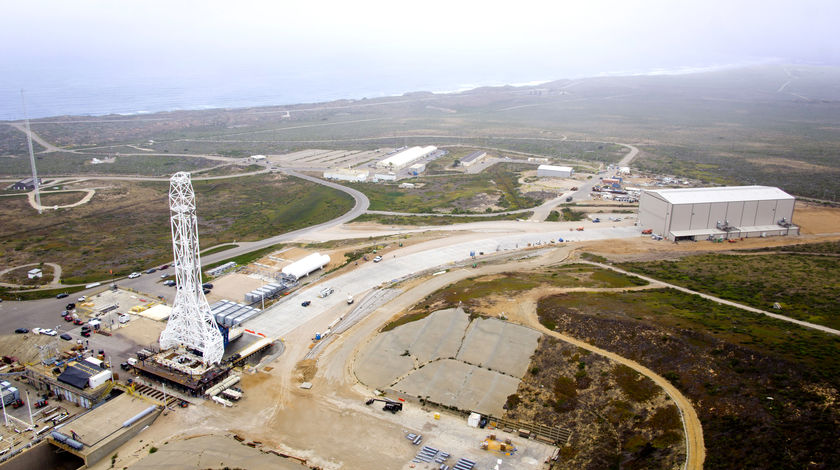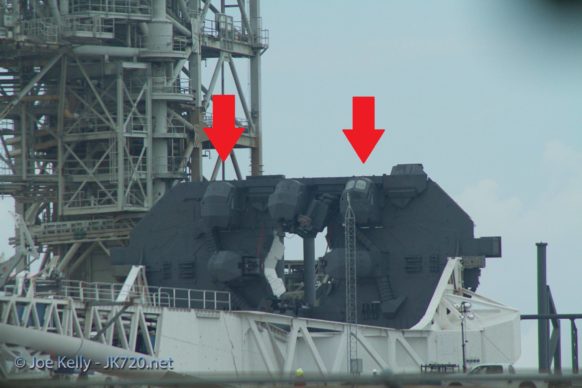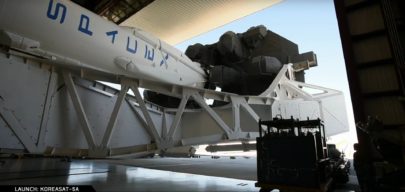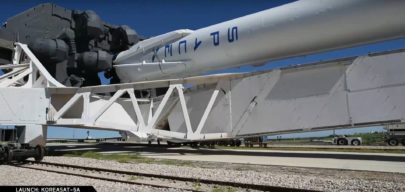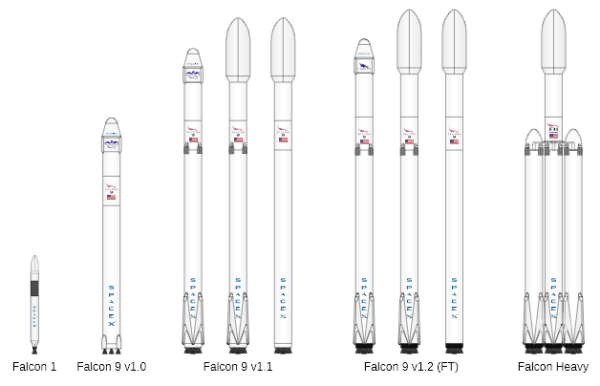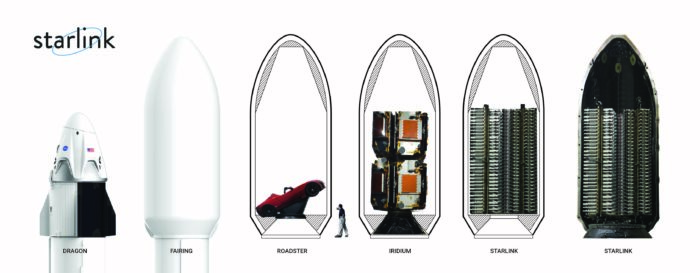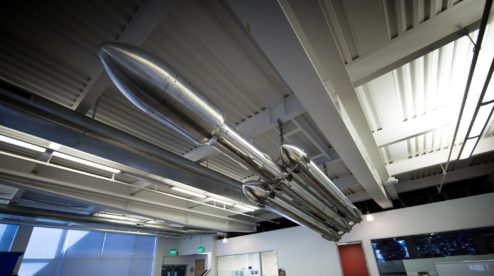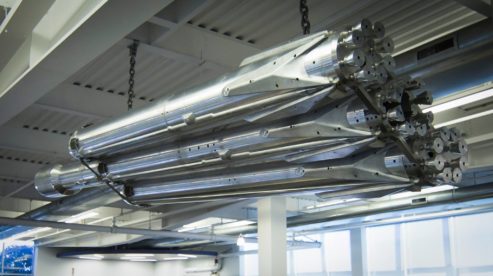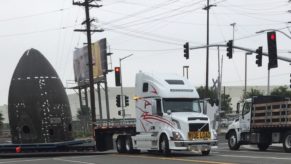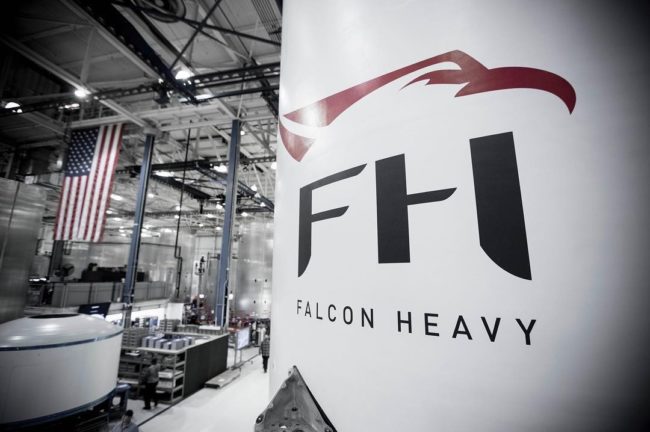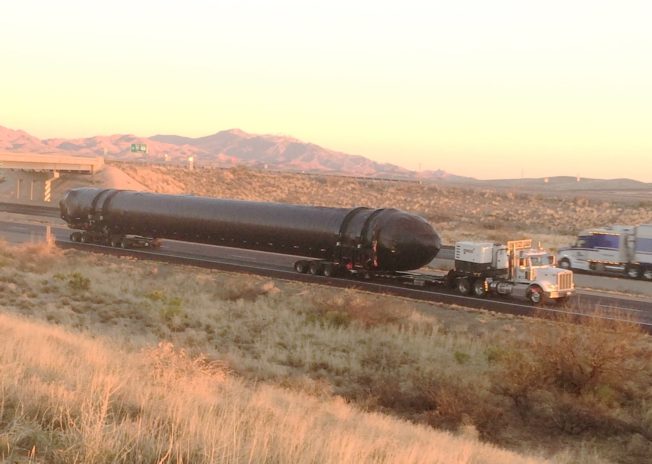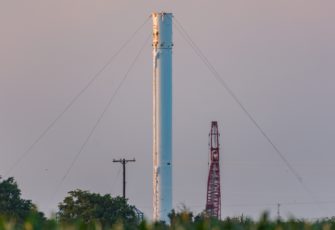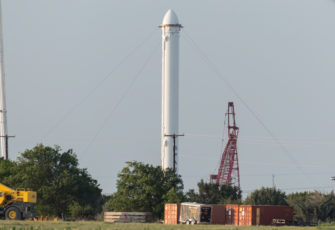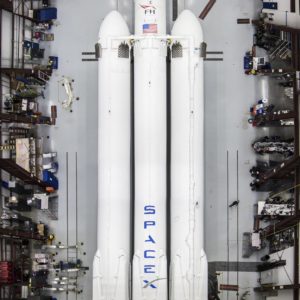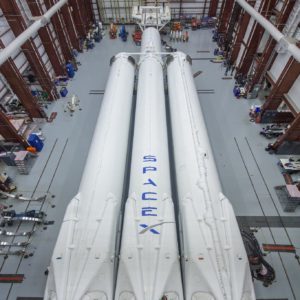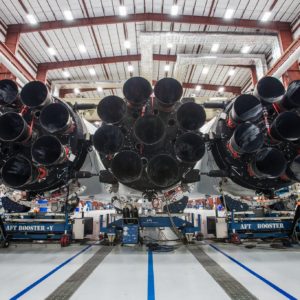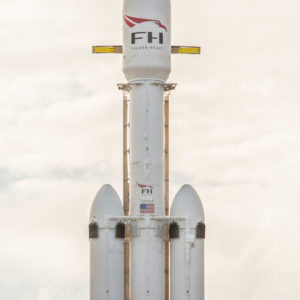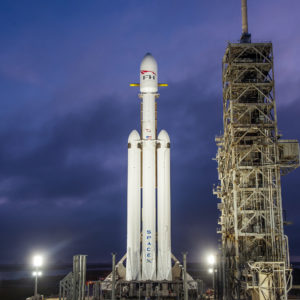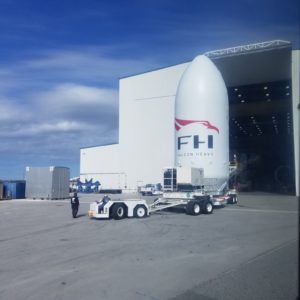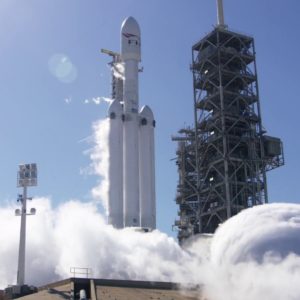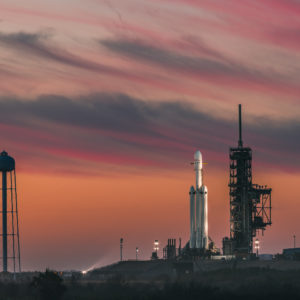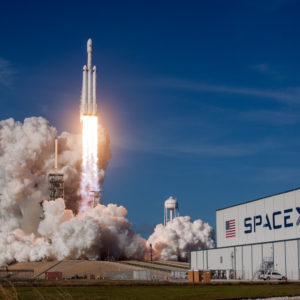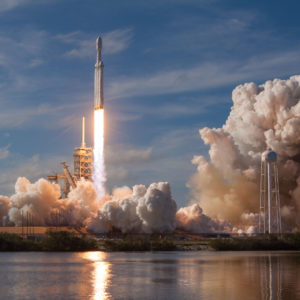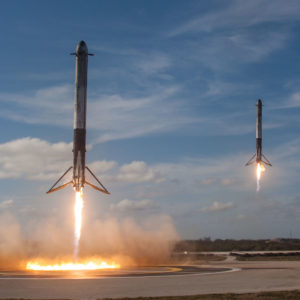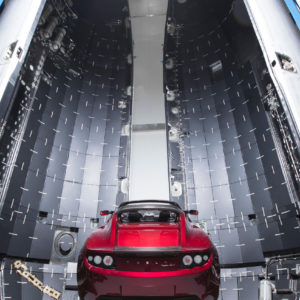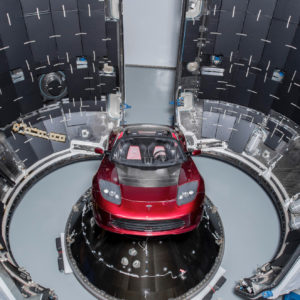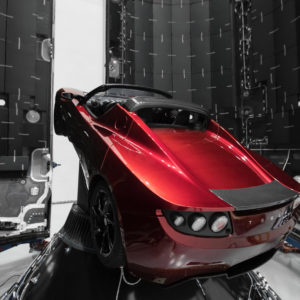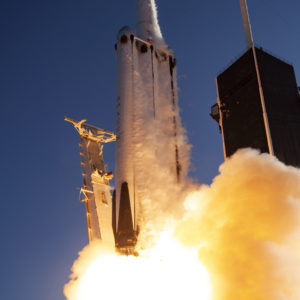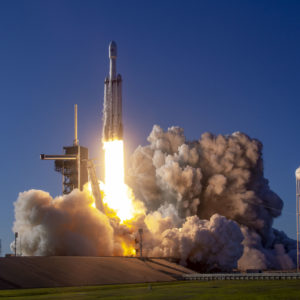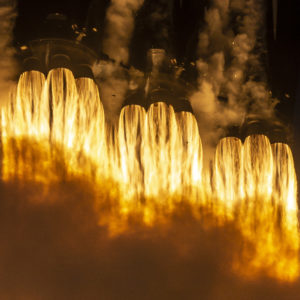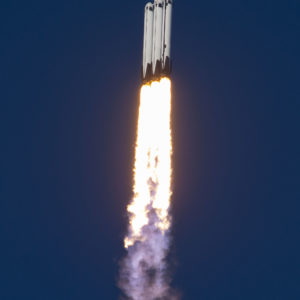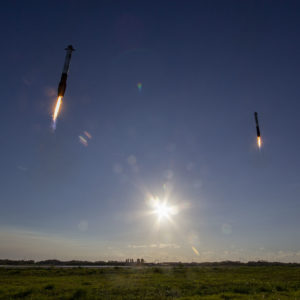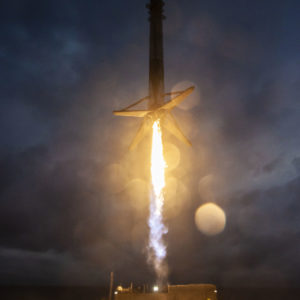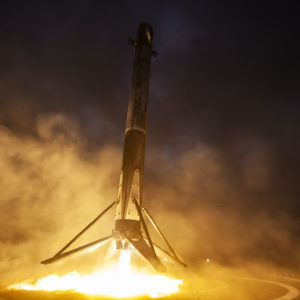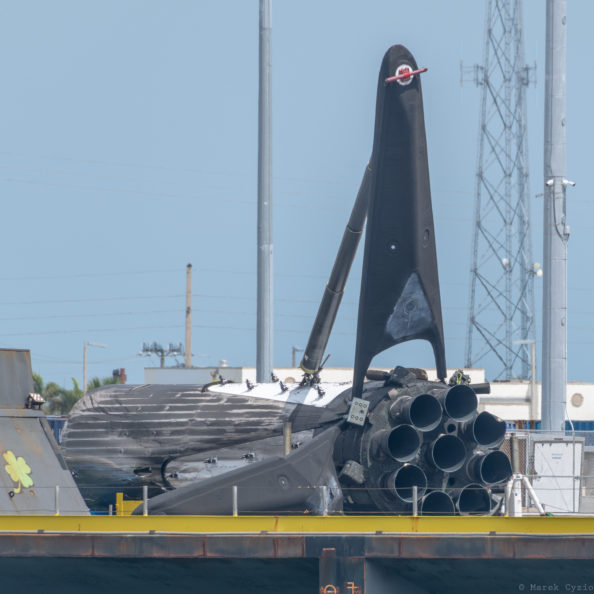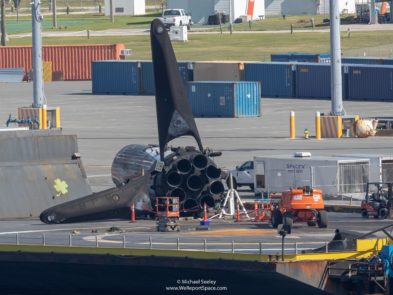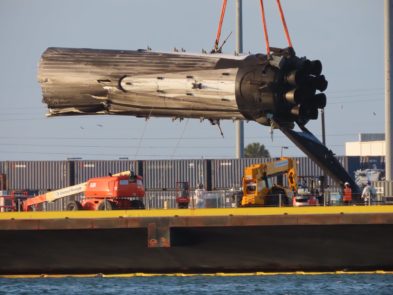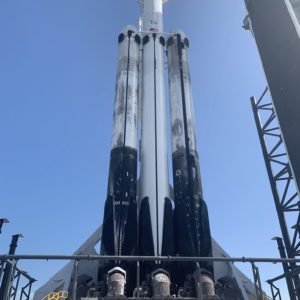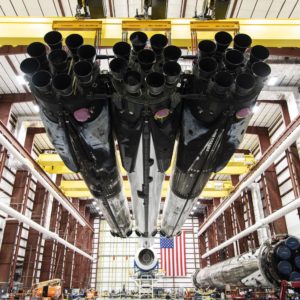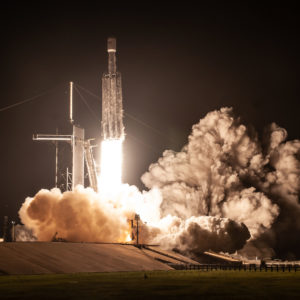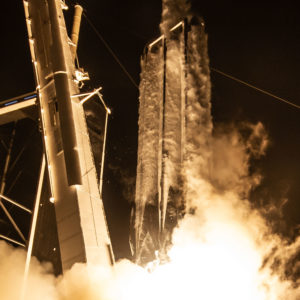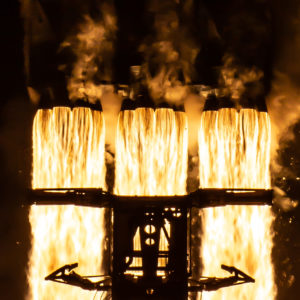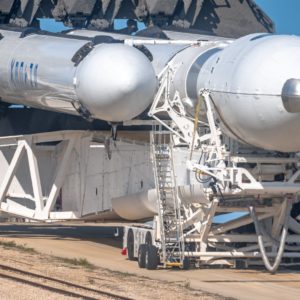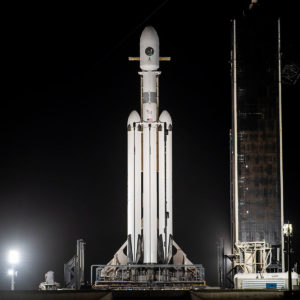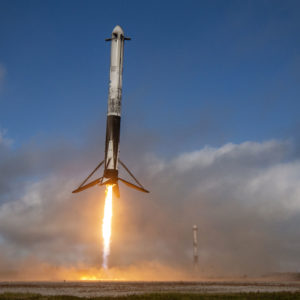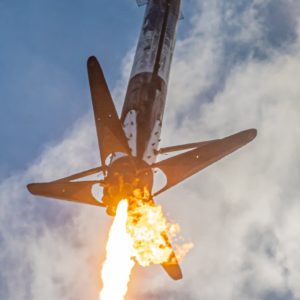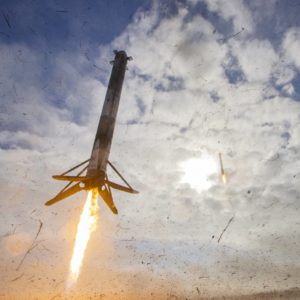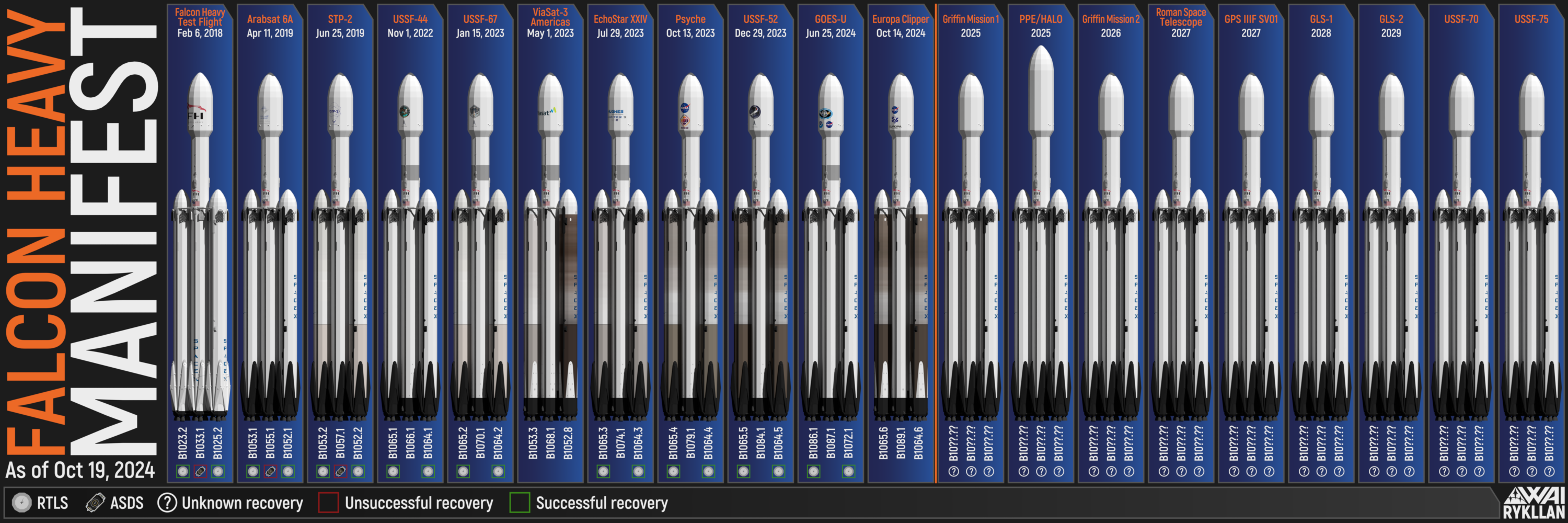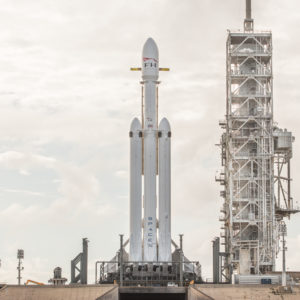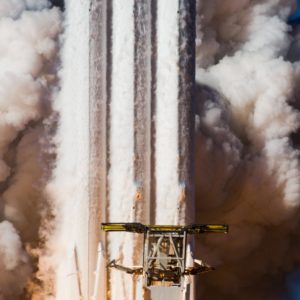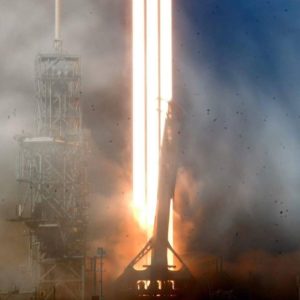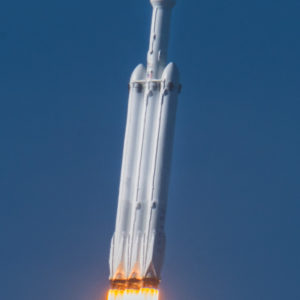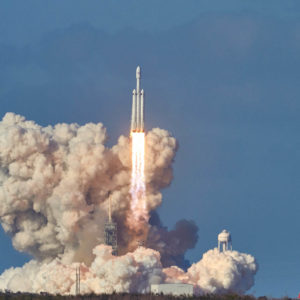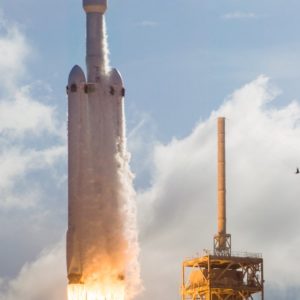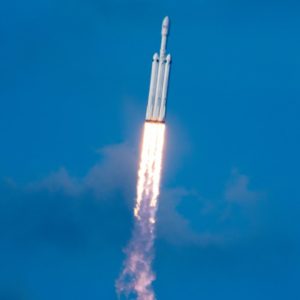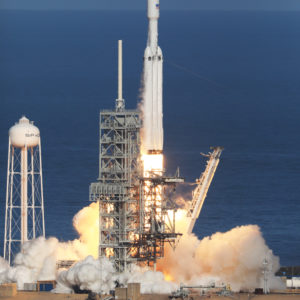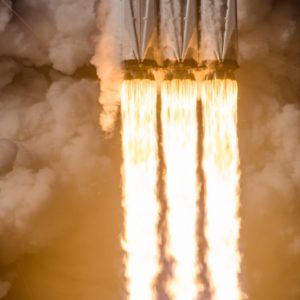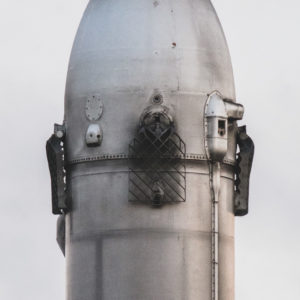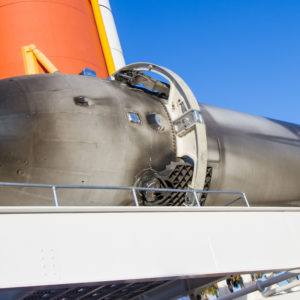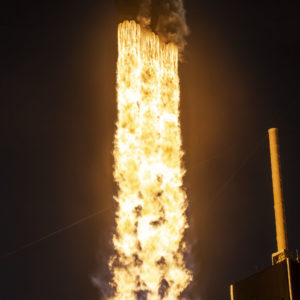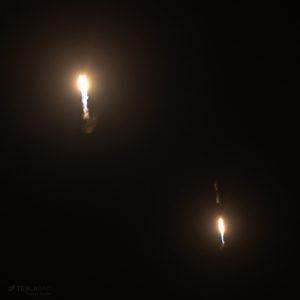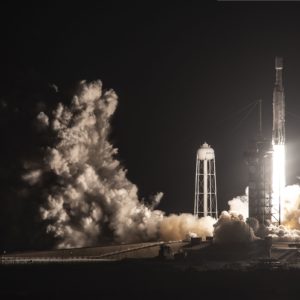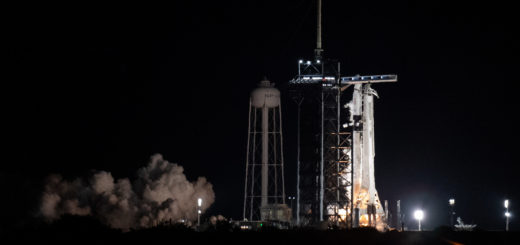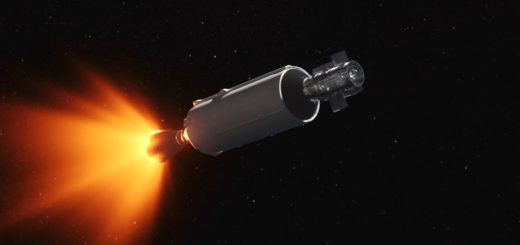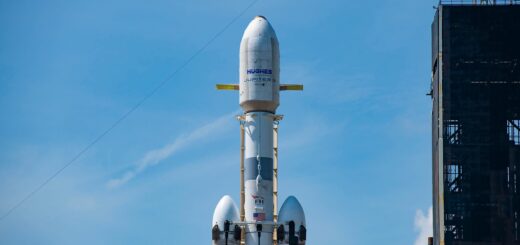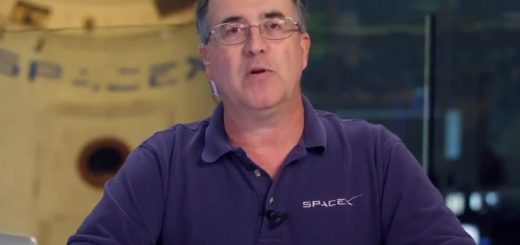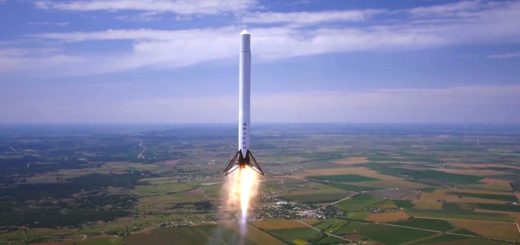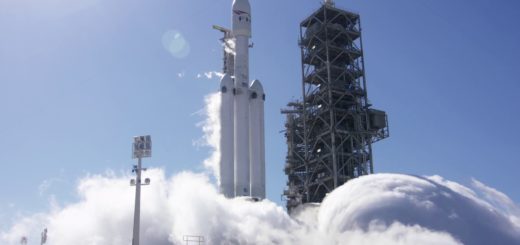Falcon Heavy Compendium
This article will be regularly updated based on the latest information (list of recent changes can be found at the end of the article). You can easily access the article from the main menu in the “Compendiums” section.
Last Update: October 19, 2024
(changelog)
Falcon Heavy (FH) is the most powerful member of SpaceX’s Falcon rocket family. Public first learned about FH back in 2005, a few years before Falcon 1’s first successful launch. In 2008, Falcon Heavy’s first launch was scheduled for 2013. The inaugural launch kept being postponed and Falcon Heavy finally launched for the first time in February 2018.
The idea behind Falcon Heavy is simple, it’s basically three Falcon 9 boosters assembled together (however, Elon Musk revealed during the SES-10 press conference that FH’s development was far more challenging than originally expected). Falcon Heavy is powered by Merlin 1D engines and was the most powerful rocket in operation at that time (having the highest thrust and LEO payload capability). However, it later lost this title to the SLS and Starship rockets, which have surpassed its capabilities. In addition, FH is able to launch large payloads beyond Earth’s orbit.
After the successful Falcon Heavy demonstration mission in February 2018, Elon Musk revealed that the rocket cost at least half a billion dollars to develop.
Skip to section:
- Parameters
- Merlin Engine
- Launch Profile and Landing Options
- Launch Pads
- Advantages Over Falcon 9
- Extended Payload Fairing
- Cancelled Plans and Features
- History of Falcon Heavy
- Details About Select Past Missions:
- Past and Future Launches
- Photos
- Videos
Parameters
- Price (real price could be higher based on type of mission and additional customer requirements):
- 90 million USD (boosters recovered)
- 97 million USD (only side boosters recovered)
- 150 million USD (expendable)
- Payload Capability:
- LEO
- 63,800 kg (expendable)
- 30,000 kg (boosters recovered)
- GTO
- 26,700 kg (expendable)
- 10,000 kg (all 3 boosters landing on droneships)
- 8,000 kg (side booster landing on land, center booster landing on droneship)
- Trans-lunar injection
- over 15,460 kg (expendable)
- 8,000 kg (all 3 boosters landing on droneships)
- 7,000 kg (side booster landing on land, center booster landing on droneship)
- Mars: 16,800 kg (expendable)
- Pluto: 3,500 kg (expendable)
- LEO
- Height: 70 m (incl. second stage and fairing)
- Width: 12.2 m (diameter of each stage: 3.66 m)
- Total Mass (fueled): 1,420,788 kg
- Total Thrust (at sea level): 22,819 kN
- Propellants: RP-1 and liquid oxygen
Merlin Engine
Merlin is an open combustion cycle rocket engine running on RP-1 (highly refined kerosene) and liquid oxygen. SpaceX manufactures several hundred of these engines per year and is therefore also the world’s largest manufacturer of rocket engines. Merlin has undergone many changes over the years and there have been several variations. Falcon Heavy uses the latest version called Merlin 1D – the rocket’s first stage consists of three cores, each equipped with 9 Merlin 1D engines, and the upper stage is propelled by a single Merlin 1D-Vac engine (a modified engine variant optimized for vacuum).
Merlin 1D has the highest thrust-to-weight ratio (TWR) of all rocket engines in the world. It was later improved to be able to throttle down to 56% of its maximum thrust, which is especially useful during landings. Additionally, enhancements have led to increased performance, reliability, and reduced manufacturing complexity. It weighs 470 kg and the latest variant has a thrust of 845 kN at sea level (981 kN in vacuum for the vacuum engine variant). This variant, sometimes referred to as Merlin 1D Block 5 or even Merlin 1E, has never failed during a mission. You can read more about this engine in this article. One of the advantages of the Merlin is its restartability (it can be easily turned off and later turned on again). This allows SpaceX to test fire each engine prior to actual launch and it also enables the first stage to land, which requires several engine restarts.
Another advantage is regenerative cooling that makes the Merlin easy to reuse. The principle behind regenerative cooling is that, before combustion in the chamber, the very cold fuel first passes through tiny channels in the walls of the engine nozzle, thereby continuously cooling it. You can see how it works in this animated diagram from Financial Times.
Tip: Watch a short video in which Tom Mueller of SpaceX explains how the Merlin engine works.
Merlin 1D was used for the first time in 2013 and is used on Falcon rockets to this day. A new feature compared to the previous Merlin 1C was the ability to throttle engine thrust down to 70% (and later to 56%). This is particularly useful when landing the first stage. Later, other enhancements have led to increased performance and reliability, and reduced manufacturing effort. Merlin 1D has never failed during a mission. The latest version of this engine, which has a slightly increased thrust and other improvements, is sometimes referred to as Merlin 1D Block 5 or even Merlin 1E.
- Merlin 1D (Credit: SpaceX)
- Merlin 1D-Vac nozzle (Credit: Steve Jurvetson)
- Merlin dual test stand in McGregor (Credit: SpaceX)
- Merlin 1D test fire in McGregor (Credit: SpaceX)
Launch Profile and Landing Options
At launch, both Falcon Heavy side boosters run at full thrust, while the center core runs at minimum thrust. After a few minutes, the side boosters separate, and the center core, along with the upper stage, continues at full thrust, eventually separating as well. All three boosters will typically attempt to land back on Earth, but there are several different landing options:
- The most common mission type involves side boosters landing on land, while the center core is expended.
- For missions to low Earth orbit or with light payloads, all three boosters can return to land. An example of such a mission is STP-2. However, since SpaceX has only two landing pads in Florida (LZ-1 and LZ-2), in such cases, the center core would land on a droneship positioned only a short distance from the coast (a few dozen kilometers instead of the usual 600–1000 km).
- The side boosters land on land, and the center core lands on a droneship further downrange, as it travels farther and at a higher velocity. This makes landing the center core more challenging compared to Falcon 9, and so far, it has only succeeded once, during the Arabsat 6A mission (although the core later tipped over during the return to port).
- For more demanding missions (with heavier payloads or higher orbits), the side boosters land on two droneships, and the center core is expended. One reason SpaceX developed the third droneship, A Shortfall of Gravitas, was the potential need to land both side boosters at sea.
- In extremely demanding missions, where maximum payload capacity is needed (such as interplanetary launches), Falcon Heavy can launch in fully expendable mode. In this case, the rocket is not equipped with landing hardware, burns all its fuel for maximum performance, and all three boosters are destroyed on impact in the ocean. An example of such a mission is the Europa Clipper.
Launch Pads
The first Falcon Heavy launch was initially planned from launch pad SLC-4E in California, but now it seems unlikely it will ever launch from that pad. It is unclear whether the pad was ever actually ready for Falcon Heavy launches, but it was designed for FH. For example, the transporter/erector (T/E) is large enough to accomodate Falcon Heavy. The pad infrastructure, however, was upgraded in 2016 in order to support subcooled propellants used by the new Falcon variant v1.2, but pad compatibility with Falcon Heavy was presumably not maintained when the upgrades were made. This is supported by the fact that the latest revision of the Falcon User’s Guide no longer offers Falcon Heavy launches from California.
Falcon Heavy eventually launched for the first time from Florida’s pad LC-39A at Kennedy Space Center. The first SpaceX launch from this pad took place in February 2017, but initially only the smaller Falcon 9 rocket could be launched from here. The pad’s construction became a priority after the nearby pad SLC-40 was destroyed in September 2016 during the Amos-6 anomaly. After SpaceX started using the completed pad LC-39A, additional work was still needed to make it compatible with Falcon Heavy. SpaceX did this work in between Falcon 9 launches during 2017.
On October 1, 2017, photos of the transporter/erector on pad ramp 39A appeared, showing two newly mounted FH side booster clamps. At the end of October, shots from Falcon 9’s roll-out seen during the live KoreaSat 5A webcast showed that the work progressed further and additional clamps were installed. The T/E modifications were probably completed in November, as the fully-assembled Falcon Heavy was mated to it by early December.
LC-39A is currently the only pad from which Falcon Heavy can launch, but the SpaceX pad that’s being built in South Texas near Boca Chica Village was also originally intended to launch Falcon 9 and Falcon Heavy rockets. However, plans have changed over the years, and SpaceX has decided that the Texas pad will be used primarily to launch the upcoming Super Heavy Starship.
However, in 2023, SpaceX leased the SLC-6 pad in California, which was previously used by ULA for Delta IV launches. The pad is expected to be operational in 2025 and will include Falcon Heavy launches.
Advantages Over Falcon 9
Falcon Heavy has triple the thrust of the smaller Falcon 9, and thus roughly three times the payload capacity. As a result, the rocket is capable of carrying payloads directly to geostationary orbit and still recover the boosters. Falcon 9 does not have enough performance for this.
Falcon Heavy’s higher payload capacity also means satellites can be deployed to a higher than standard (supersynchronous) geostationary transfer orbit. That way, the customer saves time and money because the satellite reaches final geostationary orbit sooner and consumes less fuel, which can then be used to maintain orbit for longer, which actually extends the overall lifetime of the satellite. Although Falcon 9 can also launch a heavy satellite into a supersynchronous orbit, it’s usually only possible in expendable configuration (first stage is not recovered). However, boosters being expended are a waste of resources for SpaceX, and so it is better to use Falcon Heavy for such missions because it is capable of recovering three boosters even after launching payloads to a supersynchronous orbit, as demonstrated by the Arabsat 6A mission.
Extended Payload Fairing
In May 2019, the U.S. Air Force announced the second phase of contracts for military payload launches, with companies such as ULA, SpaceX, Blue Origin, and Northrop Grumman competing. The Air Force selected two companies that will divide approximately 30 lucrative contracts between 2022 and 2026. Some of these missions, however, may require vertical payload integration, launching heavy satellites to demanding orbits, or larger payload fairings (you can find a detailed breakdown of the requirements for payload capacity, orbits, and fairings here). SpaceX currently does not meet all these requirements.
SpaceX decided to enter the bidding process with its proven Falcon 9 and Falcon Heavy rockets. However, in order for these rockets to meet all the Air Force’s requirements and carry all types of payloads, SpaceX’s proposal included plans to enable vertical payload integration and to allow for the launching of large satellites that do not fit inside the current payload fairing used by SpaceX.
Vertical payload integration will be facilitated by a new mobile tower that will be built at LC-39A at Kennedy Space Center in Florida. This pad is currently used primarily for Falcon Heavy and Dragon missions. At the same time, new infrastructure for the upcoming Starship vehicle is being constructed here. The new vertical integration tower for Falcon rockets will reportedly be built on the northern side of the current pad and will be designed to withstand category 5 hurricanes. The tower will have a similar black-and-white design as the current crew access tower used for Crew Dragon missions but will be slightly taller.
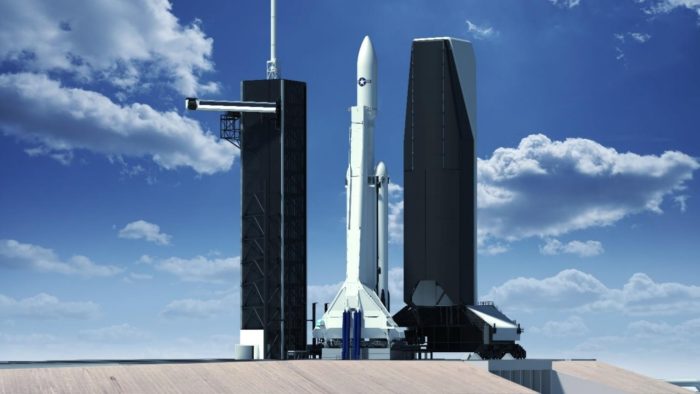
Official rendering of Falcon Heavy with the extended fairing and service tower for vertical payload integration (Credit: SpaceX)
Another feature that SpaceX is preparing to ensure that its Falcon rockets meet all military contract requirements is an extended payload fairing. This is a two-part shell at the top of the rocket that protects the payload during flight and provides the rocket with its aerodynamic shape. Falcon 9 and Falcon Heavy currently use only one type of fairing, which measures 13.9 meters in height and 5.2 meters in diameter. This fairing is not small, but it cannot accommodate all types of satellites that the Department of Defense operates or is planning. In the past, these large satellites were launched by the Delta IV Heavy rocket, which has a fairing 5.4 meters in diameter and also supports vertical payload integration. Therefore, SpaceX plans to offer a larger fairing in the future, measuring 18.6 meters in height and 5.4 meters in diameter, which will meet all military mission requirements.
Cancelled Plans and Features
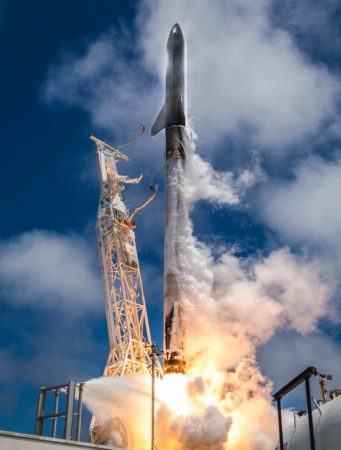
Falcon 9 with mini-BFR on top – one of the concepts for a reusable Falcon upper stage that were considered. Unofficial image. (Credit: /u/purpleefilthh)
Falcon Heavy was originally supposed to use crossfeed, which is a way of distributing fuel across rocket stages during flight. This increases efficiency and hence performance and payload capacity. However, it is a challenging engineering problem and no such system has been developed yet. Eventually, SpaceX abandoned the idea of crossfeed, saying that if it’s ever needed in the future, the company might reconsider it.
For a long time, Elon Musk also considered the idea of a reusable Falcon upper stage. He even said in March 2017 that SpaceX might attempt experimental recovery of the upper stage during the Falcon Heavy demonstration mission. However, that experiment never came to pass and Musk announced at the end of 2018 that Falcon rockets won’t be getting any more major upgrades (that means there are no plans for a reusable upper stage to be developed). SpaceX will instead focus on the development of fully-reusable Super Heavy Starship which is expected to evetually replace the Falcon rocket family anyway.
Falcon Heavy was also supposed to be capable of crewed flights. In February 2017, SpaceX announced that Falcon Heavy would send the Crew Dragon spacecraft around the moon and back. Later, however, the company changed this plan. In the fall of 2018, SpaceX announced that the private lunar flyby mission is called dearMoon and that it will be performed using BFR (now called Starship) instead of Falcon Heavy. SpaceX said that it will human-rate Falcon Heavy for crewed launches only if Super Heavy Starship development goes significantly slower than expected.
History of Falcon Heavy
The first mention of Falcon Heavy (formerly called Falcon 9 Heavy) dates back to 2005, even before the first launch of Falcon 1. In 2011, SpaceX had several Falcon 9 launches under its belt and therefore a better idea of the planned Falcon Heavy. The company initially planned to launch the first Falcon Heavy from pad SLC-4E ramp in California but that never happened. The first launch from the East Coast (Cape Canaveral) was then planned for 2013 or 2014. The company also released a video in 2011 showing a Falcon Heavy based on the now outdated Falcon 9 v1.0 variant. Another video was released in January 2015 and depicted a much updated Falcon Heavy as we know it today, even showing all three boosters landing:
In March 2015, first signs of actual Falcon Heavy development appeared online. SpaceX published (and quickly deleted) photos of the Falcon Heavy scale model used for wind-tunnel testing:
In early 2016, Falcon Heavy nose cone was spotted in the background of a photo from SpaceX’s factory in Hawthorne. Then later, that same nose cone was spotted being transported out of Hawthorne.
At the end of 2016, SpaceX published a photo on the company’s official Instagram showing the rocket interstage with Falcon Heavy logo:
In the spring of 2017, Falcon Heavy boosters were spotted being transported from Hawthorne to McGregor where they were tested afterwards:
In May 2017, the center core and one of the side boosters were test fired in McGregor. The other side booster and the upper stage were test-fired in September. SpaceX released videos from the static fires:
In October 2017, the last remaining components arrived to LC-39A and by early December, the first Falcon Heavy was assembled in the HIF (Horizontal Integration Facility). Final tests of the fully-assembled rocket could then begin in preparation for the demonstration mission.
- Assembled FH in HIF in December 2017 (Credit: SpaceX)
- Assembled FH in HIF in December 2017 (Credit: SpaceX)
- Assembled FH in HIF in December 2017 (Credit: SpaceX)
- Assembled FH in HIF in December 2017 (Credit: SpaceX)
Demonstration Mission
Pre-flight Preparations
In December 2017, SpaceX released first photos of the assembled Falcon Heavy before and after the roll-out to pad 39A where a dry dress rehearsal was conducted. In January 2018, several wet dress rehearsals took place, which culminated in a successful static fire on January 24. It was the first time that all 27 Merlin engines were ignited at once (before that, boosters could only be test fired individually in McGregor).
- Falcon Heavy on the pad (Credit: SpaceX)
- Falcon Heavy on the pad (Credit: SpaceX)
- Falcon Heavy fairing being transported to HIF (Credit: Emiliano C. Diaz de Leon)
- Falcon Heavy static fire (Credit: SpaceX)
Launch and Landing
The inaugural launch of Falcon Heavy finally happened on February 6, 2018. Side boosters landed successfully and almost simultaneously on LZ-1 and LZ-2, but the center core landing on OCISLY failed because two of the rocket’s engines ran out of TEA-TEB, a pyrophoric ignition fluid, and therefore only one of three engines needed for the landing burn ignited. The booster crashed into water right next to OCISLY.
The side boosters were reused and previously launched on Thaicom-8 and CRS-9 missions . They were Falcon 9s numbered B1023 and B1025 of the v1.2 Block 2 variant (but according to unofficial information, the boosters were essentially upgraded to Block 3 during the refurbishment process). The center core was new (number B1033), and it was a Block 3. All future FHs will consist of boosters of the much improved Block 5 version. The side boosters on this launch had titanium grid fins while the center core had aluminum fins. The reason for this was the need for better maneuverability of the side boosters due to different aerodynamics (side boosters have nose cones instead of a flat interstage).
- Falcon Heavy before launch (Credit: SpaceX)
- Falcon Heavy demonstration launch (Credit: SpaceX)
- Falcon Heavy demonstration launch (Credit: SpaceX)
- Falcon Heavy demonstration launch (Credit: SpaceX)
- FH side boosters landing on Cape Canaveral (Credit: SpaceX)
Tesla and Starman
Instead of a boring mass simulator, like a block of concrete, Elon Musk decided to use his own Tesla Roadster as the payload for this test launch. Behind the wheel was Starman, a dummy in a SpaceX spacesuit. The car spent several hours in orbit around Earth and then was successfully sent to a heliocentric orbit that reaches beyond Mars’ orbit around the Sun. According to Elon Musk, the Roadster will spend “a billion year” in space.
- Tesla Roadster before being encapsulated in the fairing (Credit: SpaceX)
- Tesla Roadster before being encapsulated in the fairing (Credit: SpaceX)
- Tesla Roadster before being encapsulated in the fairing (Credit: SpaceX)
- Tesla Roadster with Starman in orbit around Earth (Credit: SpaceX)
- Tesla Roadster with Starman in orbit around Earth (Credit: SpaceX)
- Tesla Roadster with Starman in orbit around Earth (Credit: SpaceX)
Mission Arabsat 6A
The second Falcon Heavy launch occured on April 11, 2019. It was the first flight of the upgraded Falcon Heavy Block 5 and also the rocket’s first commercial launch, carrying the Arabsat 6A satellite.
- Falcon Heavy launches the Arabsat 6A satellite (Credit: SpaceX)
- Falcon Heavy launches the Arabsat 6A satellite (Credit: SpaceX)
- Falcon Heavy launches the Arabsat 6A satellite (Credit: SpaceX)
- Falcon Heavy launches the Arabsat 6A satellite (Credit: SpaceX)
- Falcon Heavy side boosters landing during the Arabsat 6A mission (Credit: SpaceX)
- Falcon Heavy side boosters landing during the Arabsat 6A mission (Credit: SpaceX)
- Falcon Heavy center core landing on OCISLY during the Arabsat 6A mission (Credit: SpaceX)
- Falcon Heavy center core landing on OCISLY during the Arabsat 6A mission (Credit: SpaceX)
The mission was a success. The satellite was deployed in the correct supersynchronous geostationary transfer orbit, all three boosters landed successfully (first time for the center core). Both side boosters were then reused on the STP-2 mission. Even the fairings were recovered during the Arabsat launch and might be reused later.
Booster mate inside SpaceX's hangar at LC-39A ahead of Falcon Heavy’s static fire yesterday pic.twitter.com/G7ZPhOBkyj
— SpaceX (@SpaceX) April 6, 2019
Falcon Heavy’s side boosters land on Landing Zones 1 and 2 pic.twitter.com/nJCCaVHOeo
— SpaceX (@SpaceX) April 12, 2019
However, the center core tipped over some time after landing, due to rough sea conditions. The rocket was heavily damaged and OCISLY came back to port with only the bottom section of the rocket. Elon Musk stated that the engines might still be reused.
Mission STP-2
The STP-2 mission was successfully completed on June 25, 2019, and according to SpaceX, it was the most challenging mission in the company’s history. The reason was that the payload consisted of USAF’s 24 satellites that had to be deployed into three different orbits in LEO and MEO. It took over three hours and required four separate burns of the upper-stage Merlin engine. The deployment was 100% successful and SpaceX also managed to softly land the side boosters on LZ-1 and LZ-2 and to catch the rocket’s fairing for the very first time, using the ship Ms. Tree (formerly Mr. Steven) equipped with a large net.
The only flaw in this otherwise perfect launch was the unsuccessful landing of the center core on OCISLY. Elon Musk explained that “high entry force & heat breached engine bay & center engine TVC failed”. TVC stands for Thrust Vector Control and without it the center engine, which is used during landing, was unable to steer the rocket and therefore crashed in the water next to OCISLY.
- Falcon Heavy prior to the STP-2 launch (Credit: Elon Musk)
- Falcon Heavy in the HIF prior to the STP-2 launch (Credit: SpaceX)
- STP-2 launch (Credit: SpaceX)
- STP-2 launch (Credit: SpaceX)
- STP-2 launch (Credit: SpaceX)
- Falcon Heavy side boosters landing during the STP-2 mission (Credit: SpaceX)
Mission USSF-44
The USSF-44 mission was successfully completed on November 2022, over 3 years after the previous FH launch. A newly-produced rocket carried several classified payloads. This was the first SpaceX launch directly to geostationary orbit which required several-hours-long coast and multiple engine relights of the upper stage. Because of this the upper stage had a grey stripe which helps with thermal management during long coasts.
The high-energy target orbit meant that the rocket’s center core couldn’t be recovered, so it didn’t even have landing equipment. Both side boosters landed successfully on pads LZ-1 and LZ-2 at Cape Canaveral.
- Falcon Heavy prior to the USSF-44 launch (Credit: John Kraus)
- Falcon Heavy prior to the USSF-44 launch (Credit: SpaceX)
- Falcon Heavy during the USSF-44 launch (Credit: SpaceX)
- Side boosters landing during the USSF-44 launch (Credit: SpaceX)
- Side boosters landing during the USSF-44 launch (Credit: John Kraus)
- Side boosters landing during the USSF-44 launch (Credit: Jenny Hautmann)
List of All Past and Future Missions
| Date | Mission | Orbit/Target | Description |
| Feb 6, 2018 | FH Demo | Escape | Demonstration mission. The payload was Elon Musk’s Tesla Roadster. |
| Apr 11, 2019 | Arabsat 6A | GTO | First flight of the Block 5 version. The payload was a communications satellite for Saudi Arabia. |
| Jun 25, 2019 | STP-2 | LEO / MEO | Mission for the U.S. Air Force, during which 24 satellites were deployed into three different orbits. |
| Nov 1, 2022 | USSF-44 | GEO | Several classified satellites; first mission flying directly to geostationary orbit. |
| Jan 15, 2023 | USSF-67 | GEO | The military satellite CBAS 2 and the LDPE-3A deployer were launched directly into geostationary orbit. |
| May 1, 2023 | ViaSat-3 Americas | GEO | A telecommunications satellite, launched directly to geostationary orbit. No stages were recovered. |
| Jul 29, 2023 | Jupiter-3 | GTO | A more than 9-ton telecommunications satellite for EchoStar. |
| Oct 13, 2023 | Psyche | Escape | NASA probe heading to the asteroid Psyche. |
| Dec 29, 2023 | USSF-52 | GTO | SpaceX’s first contracted military mission. The payload was the X-37B mini-shuttle. |
| Jun 25, 2024 | GOES-U | GTO | A weather satellite for NOAA and NASA. |
| Oct 14, 2024 | Europa Clipper | Escape | NASA probe heading to Jupiter’s moon Europa. No stages were recovered. |
| 2025 | Griffin Mission 1 | TLI | The Griffin lunar lander with the VIPER rover. |
| 2026 | Griffin Mission 2 | TLI | The second Griffin lunar lander for Astrobotic. |
| 2027 | Roman Space Telescope | E-S L2 | A space telescope for NASA. |
| 2027 | GPS IIIF-1 | MEO | First satellite of the improved GPS third-generation series. |
| 2027 | PPE/HALO | GTO | Modules for the Gateway station. |
| 2028 | GLS-1 | TLI | A resupply mission for the lunar Gateway station with the Dragon XL spacecraft. |
| 2029 | GLS-2 | TLI | A resupply mission for the lunar Gateway station with the Dragon XL spacecraft. |
| ? | USSF-70 | GEO | Unknown payload. |
| ? | USSF-75 | GEO | Unknown payload. |
(More specific launch dates can be found on the Launch Manifest page.)
More Falcon Heavy Photos
- Falcon Heavy on pad (Credit: SpaceX)
- Falcon Heavy on pad (Credit: SpaceX)
- Falcon Heavy demo launch (Credit: Tom Cross)
- Falcon Heavy demo launch (Credit: @rocketphotography)
- Falcon Heavy demo launch (Credit: Darren Tan)
- Falcon Heavy demo launch (Credit: /u/jardeon)
- Falcon Heavy demo launch (Credit: Brady Kenniston)
- Falcon Heavy demo launch (Credit: Brady Kenniston)
- Falcon Heavy demo launch (Credit: NASA)
- Falcon Heavy demo launch (Credit: /u/jardeon)
- Falcon Heavy demo launch (Credit: Brady Kenniston)
- FH side booster after landing (Credit: Darren Tan)
- FH side booster after landing (Credit: Elon Musk)
- FH side booster displayed at KSC (Credit: Teslarati)
- FH side booster displayed at KSC (Credit: Teslarati)
- Falcon Heavy side boosters landing during the Arabsat 6A mission (Credit: SpaceX)
- Falcon Heavy launches the Arabsat 6A satellite (Credit: SpaceX)
- Falcon Heavy before the Arabsat 6A mission (Credit: SpaceX)
- Falcon Heavy before the Arabsat 6A mission (Credit: SpaceX)
- STP-2 launch (Credit: SpaceX)
- Falcon Heavy side boosters landing during the STP-2 mission (Credit: SpaceX)
- STP-2 launch (Credit: SpaceX)
- Falcon Heavy before the STP-2 launch (Credit: SpaceX)
Falcon Heavy Videos
Demo Mission Webcast:
Side Boosters Landing:
Falcon Heavy on Pad:
Falcon Heavy Going Vertical on Pad:
Demo Mission Animation:
Official Video Celebrating the Demo Mission:
Changelog:
- Oct 19, 2024 – Big update after 2 years
- Nov 2, 2022 – USSF-44 successfully launched; updated the timeline of upcoming launches
- Oct 7, 2022 – Updated the timeline of upcoming launches
- Jul 20, 2022 – Added Roman Space Telescope to the list of planned launches
- Jul 19, 2022 – Griffin Mission 1 delayed by a year
- Jun 25, 2022 – Several planned launches delayed
- May 16, 2022 – Added Jupiter-3 to the list of planned launches
- Feb 28, 2022 – Updated the list of upcoming launches (Inmarsat-6 F2 won’t launch on FH)
- Oct 31, 2021 – It has been confirmed that USSF-67 will use FH (center core will be expended)
- Oct 5, 2021 – USSF-44 launch was delayed to 2022
- Sep 10, 2021 – Added GOES-U to the list of planned launches
- Jul 23, 2021 – Added Europa Clipper to the list of planned launches
- May 19, 2021 – USSF-52 was delayed to 2022
- Apr 13, 2021 – Added Griffin Mission 1 to the list of planned launches
- Feb 11, 2021 – Updated the list of upcoming launches
- Jan 15, 2021 – Updated information about the upcoming Inmarsat mission
- Sep 25, 2020 – Updated the list of upcoming launches
- Apr 4, 2020 – Added two GLS missions with Dragon XL to the list of missions
- Mar 30, 2020 – Added payload capacity for trans-lunar injection in various configurations
- Feb 29, 2020 – Psyche added to the list of missions
- Feb 11, 2020 – Updated the section about NSSL certification and added the Inmarsat 6B launch (not yet confirmed)
- Aug 23, 2019 – Ovzon-3 removed from the list of missions (will launch on Ariane 5)
- Jun 27, 2019 – Added information and photos from the STP-2 launch + updated the mission manifest
- Apr 21, 2019 – Added information and photos about the Arabsat center core mishap
- Apr 14, 2019 – Added some basic information about Arabsat 6A launch (more details will be added later)
- Mar 31, 2019 – Article first published




